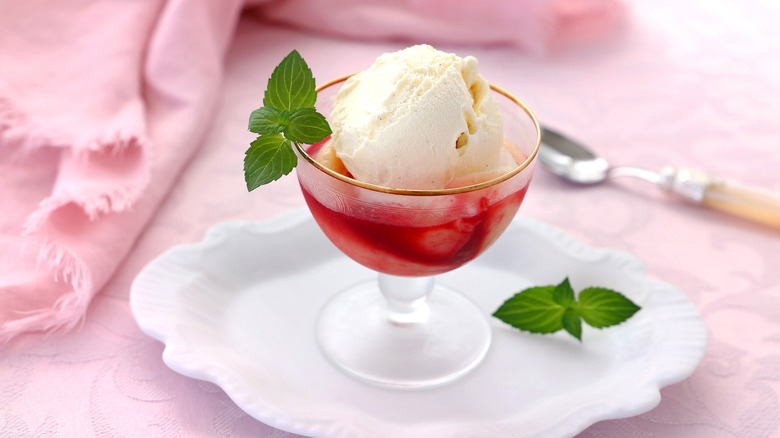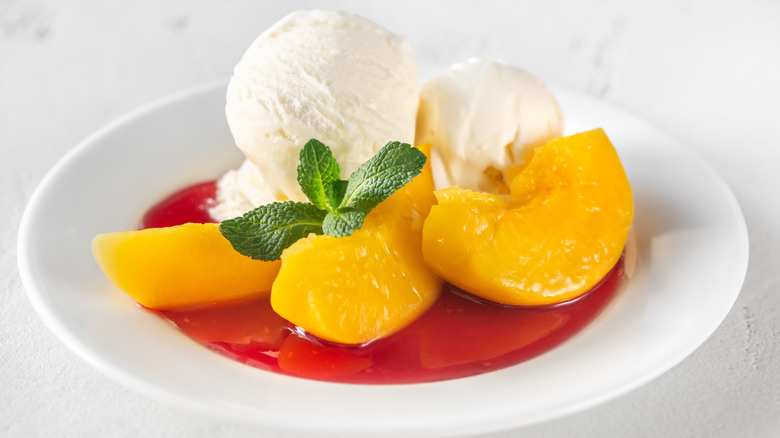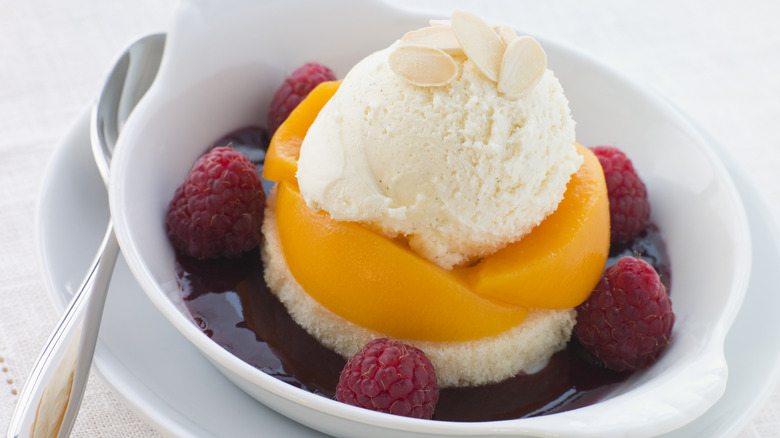How The Legendary Peach Melba Got Its Name
While a night at the opera can soar with romanticism and lyrical splendor, the simplicity of the classic dessert, Peach Melba, delights the palate with elegance. Created by the legendary chef Auguste Escoffier for Australian opera singer Nellie Melba, this ode to the swan continues to march onto dessert menus across the globe.
Often referred to as "the king of chefs and the chef of kings," Auguste Escoffier rose to fame during this tenure at The Savoy Hotel. According to The Savoy London, the Duke of Orléans, who was having a public affair with Melba, commissioned a dinner to celebrate opera singer, Nellie Melba, who was performing in Wagner's opera, Lohengrin, at Covenant Garden. Although the "Wedding March" might be the most well-known piece from that opera, it was the swan-shaped boat in the story that inspired this classic confection. When originally conceived, the dessert was called "Pêche au Cygne" (peach with the swan). Delicate spun sugar topped a bowl of poached peaches and vanilla ice cream, which was served in a silver bowl surrounded by a carved ice swan.
Several years later, the dessert's recipe changed. During his time at Ritz Carlton London, Escoffier replaced the spun sugar with raspberry puree and named it Pêche Melba (Peach Melba). Today, the simple, fruit-forward dessert continues to be served in restaurants and homes throughout the world.
What did Escoffier say about the Peach Melba?
Auguste Escoffier is often accredited with the idea that simplicity is best when it comes to food, and the classic Peach Melba is an example of that philosophy. Juicy, tender, ripe peaches topped with a luscious vanilla ice cream and drizzled with a sweet, yet slightly tart, raspberry puree does not need additional ingredients to excite the palate.
In his autobiography "Memories of My Life," Escoffier commented that the recipe was changed too often for his taste. The swift and wide-reaching success of that dessert was because of the inherent delicate balance of flavors. Adamantly criticizing the use of whipped cream instead of ice cream or a fruit jam for the raspberry puree, Escoffier believes these variations were ill-advised.
Escoffier did allow one variation on the classic dish. During almond season, he permitted slivers of fresh almonds to be sprinkled on top of the peaches and raspberry puree. While some people might not appreciate the flavor specificity of fresh versus dried almonds, the idea seems to refer back to his basic philosophy, simple is best. The peaches, ice cream, and raspberry puree should never be overshadowed by other superfluous ingredients.
Did Peach Melba inspire other desserts?
Even if Escoffier might disapprove of any variation to the classic Peach Melba, the simple dessert appears to have influenced other sweet creations. In some ways, it appears to have inspired the classic All-American sundae. The combination of ice cream, sauce, and fruit fills bowls in various ways. While that statement can be debated, the connection seems to fit in that bowl.
The classic Peach Melba has had its own variations. From swapping nectarines for peaches or using another berry jam for the raspberries, the flavor is altered but the simplicity of the dessert remains. At its heart, the dessert is contrasting fruit and cream. It goes back to Escoffier's philosophy: simple is best.
In the end, poached peaches, a tart raspberry sauce, and a luscious ice cream can be a lovely note to finish a meal. It might not necessarily make a splash like the high note of an aria, but its deliciousness is a flavorful affair for the ages.


